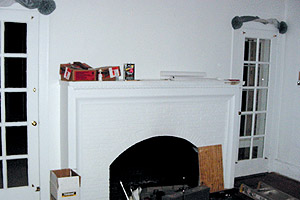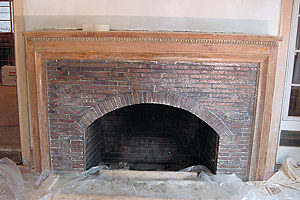
Stripping Coatings
from Masonry
Stripping paint from the porous surface of masonry block starts off pretty much like stripping paint from any other surface. It's the follow-up that's a real drag.
by David Thompson
of masonry block starts off pretty much like stripping paint from any other surface. It’s the follow-up that’s a real drag.
Actually, if you can use a power washer to blast every tiny pit in the masonry clean, the follow-up isn’t so bad (so long as surrounding areas are well-barricaded from flying paint sludge). But if power washing isn’t practical, then it may take repeated flushing and scrubbing to get good results. Dip, scrub, dip, scrub, dip, scrub. And repeat.
 Apart from that, masonry block isn’t much different from other surfaces when it comes to stripping. The same types of products can generally be used across the board. Apart from that, masonry block isn’t much different from other surfaces when it comes to stripping. The same types of products can generally be used across the board.
Caustic paint removers will remove multiple layers of latex or alkyd paints from masonry, though they won’t get two-component epoxies or urethanes off much of anything.
Dumond Chemical’s popular line of Peel-Away strippers features a couple of products that contain caustics. Peel-Away I is used when the original coat of paint is oil-based, and Peel-Away VII is used when the original coat is latex. It doesn’t matter what subsequent coats are.
“Between Peel Away I and Peel-Away VII, no matter what you’ve got on the surface, odds are one or the other is going to do the job for you,” says Hy Dubin, president of Dumond Chemicals. “You put it on, cover it with paper, leave it overnight, and when you power wash it off — that’s the easiest way — you’ll be right down to the bare surface.”
Caustics are relatively inexpensive, but they have to be applied thickly, from 1⁄8 inch to 1⁄4 inch, so their square-foot-per-gallon ratio isn’t all that great. They also require a neutralization step, which adds to the labor cost. And workers’ eyes, skin and lungs need to be protected when working with caustics since they are, after all, caustic. Sodium hydroxide, or lye, is a key ingredient.
In some cases caustics might not be the best stripper choice for masonry, according to Janice Nachbaer, national sales manager for Back to Nature, which makes a caustic stripper as well as a more environmentally friendly line of strippers. The porous nature of masonry can become an issue when it’s time to neutralize a caustic, she says.
“Sometimes it’s hard with a very porous substrate to get the right pH balance,” she says. “There’s a very specific range you have to get it within. If you don’t get the pH just right and you repaint, the paint dies.”
The latest development in the world of strippers is the advent of safer-to-use, more environmentally friendly products. A lot of them are based on n-methyl-2 pyrrolidone (NMP). Back to Nature, whose stripper line includes Multi-Strip and Ultra-Strip, is among the many manufacturers who have developed new-generation strippers around NMP.
“They don’t burn, they don’t hurt, they don’t smell — and they take off a lot of paint,” says Nachbaer. “And you don’t need to neutralize them.”
NMP removes a variety of coatings, although it won’t work on more chemical-resistant materials such as epoxies and polyurethanes. Like everything in the safer generation of strippers, these take longer to do their job than their more dangerous predecessors. While NMP isn’t as toxic as the older strippers, it’s not entirely benign. In California, products with NMP carry a label warning that they may cause cancer and birth defects. |

